| Part of a series on |
| The Cambrian explosion |
|---|
 |
| Phylogenetic position of the urbilaterian | |||
|
The urbilaterian (from German ur- 'original') is the hypothetical last common ancestor of the bilaterian clade, i.e., all animals having a bilateral symmetry.
| Part of a series on |
| The Cambrian explosion |
|---|
 |
| Phylogenetic position of the urbilaterian | |||
|
The urbilaterian (from German ur- 'original') is the hypothetical last common ancestor of the bilaterian clade, i.e., all animals having a bilateral symmetry.
Its appearance is a matter of debate, for no representative has been (or may or may not ever be) identified in the fossil record. Two reconstructed urbilaterian morphologies can be considered: first, the less complex ancestral form forming the common ancestor to Xenacoelomorpha and Nephrozoa; and second, the more complex (coelomate) urbilaterian ancestral to both protostomes and deuterostomes, sometimes referred to as the "urnephrozoan". Since most protostomes and deuterostomes share features — e.g. nephridia (and the derived kidneys), through guts, blood vessels and nerve ganglia— that are useful only in relatively large (macroscopic) organisms, their common ancestor ought also to have been macroscopic. However, such large animals should have left traces in the sediment in which they moved, and evidence of such traces first appear relatively late in the fossil record — long after the urbilaterian would have lived. This leads to suggestions of a small urbilaterian (around 1 mm) which is the supposed state of the ancestor of protostomes, deuterostomes and acoelomorphs.
The first evidence of bilateria in the fossil record comes from trace fossils in sediments towards the end of the Ediacaran period (about 570 million years ago), and the first fully accepted fossil of a bilaterian organism is Kimberella , dating to 555 million years ago. [1] There are earlier, controversial fossils: Vernanimalcula has been interpreted as a bilaterian, but may simply represent a fortuitously infilled bubble. [2] Fossil embryos are known from around the time of Vernanimalcula ( 580 million years ago), but none of these have bilaterian affinities. [3] This may reflect a genuine absence of bilateria, however it is likely this is the case as bilateria may not have laid their eggs in sediment, where they would be likely to fossilise. [4]
Molecular techniques can generate expected dates of the divergence between the bilaterian clades, and thus an assessment of when the urbilaterian lived. These dates have huge margins of error, though they are becoming more accurate with time. More recent estimates are compatible with an Ediacaran bilaterian, although it is possible, especially if early bilaterians were small, that the bilateria had a long cryptic history before they left any evidence in the fossil record. [5]
Light detection (photosensitivity) is present in organisms as simple as seaweeds; the definition of a true eye varies, but in general eyes must have directional sensitivity, and thus have screening pigments so only light from the target direction is detected. Thus defined, they need not consist of more than one photoreceptor cell. [6]
The presence of genetic machinery (the Pax6 and Six genes) common to eye formation in all bilaterians suggests that this machinery - and hence eyes - was present in the urbilaterian. [6] The most likely candidate eye type is the simple pigment-cup eye, which is the most widespread among the bilateria. [6]
Since two types of opsin, the c-type and r-type, are found in all bilaterians, the urbilaterian must have possessed both types - although they may not have been found in a centralised eye, but used to synchronise the body clock to daily or lunar variations in lighting. [7]
Proponents of a complex urbilaterian point to the shared features and genetic machinery common to all bilateria. They argue that (1) since these are similar in so many respects, they could have evolved only once; and (2) since they are common to all bilateria, they must have been present in the ancestral bilaterian animal.
However, as biologists' understanding of the major bilaterian lineages increases, it is beginning to appear that some of these features may have evolved independently in each lineage. Further, the bilaterian clade has recently been expanded to include the acoelomorphs — a group of relatively simple flatworms. This lineage lacks key bilaterian features, and if it truly does reside within the bilaterian "family", many of the features listed above are no longer common to all bilateria. [8] Instead, some features — such as segmentation and possession of a heart — are restricted to a sub-set of the bilateria, the deuterostomes and protostomes. Their last common ancestor would still have to be large and complex, but the bilaterian ancestor could be much simpler. [8] However, some scientists stop short of including the acoelomorph clade in the bilateria. This shifts the position of the cladistic node which is being discussed; consequently the urbilaterian in this context is farther out the evolutionary tree and is more derived than the common ancestor of deuterostomes, protostomes and acoelomorphs. [9]
Genetic reconstructions are unfortunately not much help. They work by considering the genes common to all bilateria, but problems arise because very similar genes can be co-opted for different functions. For instance, the gene Pax6 has a function in eye development, but is absent in some animals with eyes; some cnidaria have genes which in bilateria control the development of a layer of cells that the cnidaria do not have. This means that even if a gene can be identified as present in the urbilaterian, we cannot necessary tell what the gene's function was. [8] Before this was realised, genetic reconstructions implied an implausibly complex urbilaterian. [5]
The evolutionary developmental biologist Lewis Held notes that both centipedes and snakes use the oscillating mechanism based on the Notch signaling pathway to produce segments from the growing tip at the rear of the embryo. Further, both groups make use of "the obtuse process of 'resegmentation', whereby the phase of their metameres shifts by half a unit of wavelength, i.e. somites splitting to make vertebrae or parasegments splitting to form segments." [10] Held comments that all this makes it difficult to imagine that their urbilaterian common ancestor was not segmented. [10]

The absence of a fossil record gives a starting point for the reconstruction — the urbilaterian must have been small enough not to leave any traces as it moved over or lived in the sediment surface. This means it must have been well below a centimetre in length. As all Cambrian animals are marine, one can reasonably assume that the urbilaterian was too. [8]
Furthermore, a reconstruction of the urbilateria must rest on identifying morphological similarities between all bilateria. While some bilateria live attached to a substrate, this appears to be a secondary adaptation, and the urbilaterian was probably mobile. [8] Its nervous system was probably dispersed, but with a small central "brain". Since acoelomorphs lack a heart, coelom or organs, the urbilaterian probably did too — it would presumably have been small enough for diffusion to do the job of transporting compounds through the body. [8] A small, narrow gut was probably present, which would have had only one opening — a combined mouth and anus. [8] Functional considerations suggest that the surface of the bilaterian was probably covered with cilia, which it could have used for locomotion or feeding. [8]
As of 2018 [update] there is still no consensus on whether the characteristics of the deuterostomes and protostomes evolved once or many times. Features such as a heart and a blood-circulation system may therefore not have been present even in the deuterostome-protostome ancestor, which would mean that this too could have been small (hence explaining the lack of fossil record). [5]
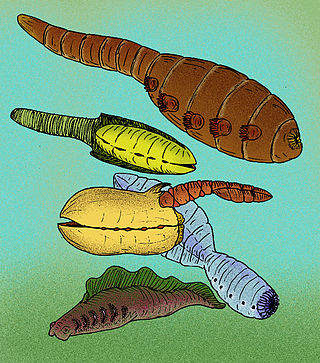
Vetulicolia is a phylum of bilaterian animals encompassing several extinct species belonging to the Cambrian period. The phylum was created by Degan Shu and his research team in 2001, and named after Vetulicola cuneata, the first species of the phylum described in 1987.

Bilateria is a large clade or infrakingdom of animals called bilaterians, characterized by bilateral symmetry during embryonic development. This means their body plans are laid around a longitudinal axis with a front and a rear end, as well as a left–right–symmetrical belly (ventral) and back (dorsal) surface. Nearly all bilaterians maintain a bilaterally symmetrical body as adults; the most notable exception is the echinoderms, which extend to pentaradial symmetry as adults, but are only bilaterally symmetrical as an embryo. Cephalization is also a characteristic feature among most bilaterians, where the special sense organs and central nerve ganglia become concentrated at the front/rostral end.
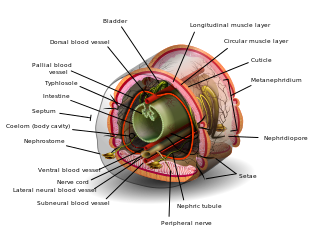
The coelom is the main body cavity in many animals and is positioned inside the body to surround and contain the digestive tract and other organs. In some animals, it is lined with mesothelium. In other animals, such as molluscs, it remains undifferentiated. In the past, and for practical purposes, coelom characteristics have been used to classify bilaterian animal phyla into informal groups.

Kimberella is an extinct genus of bilaterian known only from rocks of the Ediacaran period. The slug-like organism fed by scratching the microbial surface on which it dwelt in a manner similar to the gastropods, although its affinity with this group is contentious.

Acoelomorpha is a subphylum of very simple and small soft-bodied animals with planula-like features which live in marine or brackish waters. They usually live between grains of sediment, swimming as plankton, or crawling on other organisms, such as algae and corals. With the exception of two acoel freshwater species, all known acoelomorphs are marine.
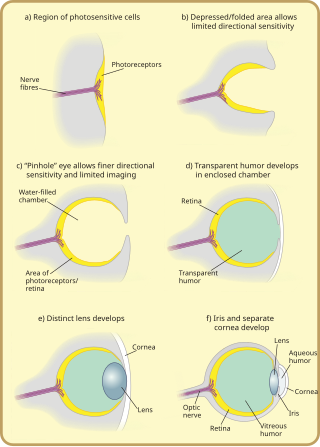
Many scientists have found the evolution of the eye attractive to study because the eye distinctively exemplifies an analogous organ found in many animal forms. Simple light detection is found in bacteria, single-celled organisms, plants and animals. Complex, image-forming eyes have evolved independently several times.
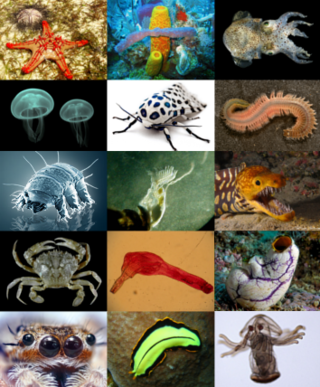
Animals are multicellular, eukaryotic organisms in the biological kingdom Animalia, With few exceptions, animals consume organic material, breathe oxygen, have myocytes and are able to move, can reproduce sexually, and grow from a hollow sphere of cells, the blastula, during embryonic development. Animals form a clade, meaning that they arose from a single common ancestor.
As understanding of the events of the Cambrian becomes clearer, data have accumulated to make some postulated causes for the Cambrian explosion look improbable. Some examples are the evolution of herbivory, vast changes in plate tectonic rates or orbital motion, or different evolutionary mechanisms in force.
The Cambrian explosion is an interval of time approximately 538.8 million years ago in the Cambrian period of the early Paleozoic when there was a sudden radiation of complex life, and practically all major animal phyla started appearing in the fossil record. It lasted for about 13 to 25 million years and resulted in the divergence of most modern metazoan phyla. The event was accompanied by major diversification in other groups of organisms as well.
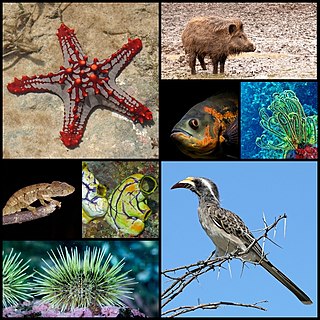
Deuterostomes are bilaterian animals of the superphylum Deuterostomia, typically characterized by their anus forming before the mouth during embryonic development. Deuterostomia is further divided into 4 phyla: Chordata, Echinodermata, Hemichordata, and the extinct Vetulicolia known from Cambrian fossils. The extinct clade Cambroernida is also thought to be a member of Deuterostomia.

Protostomia is the clade of animals once thought to be characterized by the formation of the organism's mouth before its anus during embryonic development. This nature has since been discovered to be extremely variable among Protostomia's members, although the reverse is typically true of its sister clade, Deuterostomia. Well known examples of protostomes are arthropods, molluscs, annelids, flatworms and nematodes. They are also called schizocoelomates since schizocoely typically occurs in them.

The embryological origin of the mouth and anus is an important characteristic, and forms the morphological basis for separating bilaterian animals into two natural groupings: the protostomes and deuterostomes.
The Urmetazoan is the hypothetical last common ancestor of all animals, or metazoans. It is universally accepted to be a multicellular heterotroph — with the novelties of a germline and oogamy, an extracellular matrix (ECM) and basement membrane, cell-cell and cell-ECM adhesions and signaling pathways, collagen IV and fibrillar collagen, different cell types, spatial regulation and a complex developmental plan, and relegated unicellular stages.

Planulozoa is a clade which includes the Placozoa, Cnidaria and the Bilateria. The designation Planulozoa may be considered a synonym to Parahoxozoa. Within Planulozoa, the Placozoa may be a sister of Cnidaria to the exclusion of Bilateria. The clade excludes basal animals such as the Ctenophora, and Porifera (sponges). Although this clade was sometimes used to specify a clade of Cnidaria and Bilateria to the exclusion of Placozoa, this is no longer favoured due to recent data indicating a sister group relationship between Cnidaria and Placozoa.
In evolutionary developmental biology, inversion refers to the hypothesis that during the course of animal evolution, the structures along the dorsoventral (DV) axis have taken on an orientation opposite that of the ancestral form.
The evolution of nervous systems dates back to the first development of nervous systems in animals. Neurons developed as specialized electrical signaling cells in multicellular animals, adapting the mechanism of action potentials present in motile single-celled and colonial eukaryotes. Primitive systems, like those found in protists, use chemical signalling for movement and sensitivity; data suggests these were precursors to modern neural cell types and their synapses. When some animals started living a mobile lifestyle and eating larger food particles externally, they developed ciliated epithelia, contractile muscles and coordinating & sensitive neurons for it in their outer layer.

Xenacoelomorpha is a small phylum of bilaterian invertebrate animals, consisting of two sister groups: xenoturbellids and acoelomorphs. This new phylum was named in February 2011 and suggested based on morphological synapomorphies, which was then confirmed by phylogenomic analyses of molecular data.
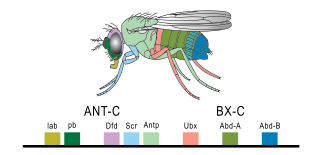
The evo-devo gene toolkit is the small subset of genes in an organism's genome whose products control the organism's embryonic development. Toolkit genes are central to the synthesis of molecular genetics, palaeontology, evolution and developmental biology in the science of evolutionary developmental biology (evo-devo). Many of them are ancient and highly conserved among animal phyla.

Xenoturbella bocki is a marine benthic worm-like species from the genus Xenoturbella. It is found in saltwater sea floor habitats off the coast of Europe, predominantly Sweden. It was the first species in the genus discovered. Initially it was collected by Swedish zoologist Sixten Bock in 1915, and described in 1949 by Swedish zoologist Einar Westblad. The unusual digestive structure of this species, in which a single opening is used to eat food and excrete waste, has led to considerable study and controversy as to its classification. It is a bottom-dwelling, burrowing carnivore that eats mollusks.
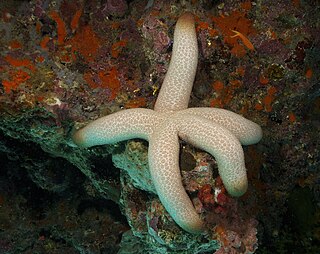
Xenambulacraria is a proposed clade of animals with bilateral symmetry as an embryo, consisting of the Xenacoelomorpha and the Ambulacraria.